

Fly-over of MEAN Stack: Six Need-to-Knows. MEAN Stack Tutorial MongoDB ExpressJS AngularJS NodeJS (Part III) - Adrian Mejia’s Blog. This is the last part of three-series tutorial.
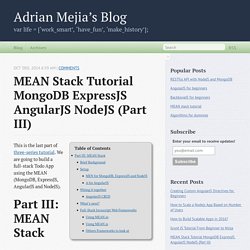
We are going to build a full-stack Todo App using the MEAN (MongoDB, ExpressJS, AngularJS and NodeJS). Brief Background TL; DR: NodeJS has been built from bottom up a non-blocking I/O paradigm, which gives you more efficiency per CPU core than using threads in other languages like Java. Get started here. Deploy Your Own REST API in 30 Mins Using mLab and Heroku. This article was first published on the Heroku Dev Center The MEAN stack is a popular web development stack made up of MongoDB, Express, AngularJS, and Node.js.

MEAN has gained popularity because it allows developers to program in JavaScript on both the client and the server. The MEAN stack enables a perfect harmony of JavaScript Object Notation (JSON) development: MongoDB stores data in a JSON-like format, Express and Node.js facilitate easy JSON query creation, and AngularJS allows the client to seamlessly send and receive JSON documents. MEAN is generally used to create browser-based web applications because AngularJS (client-side) and Express (server-side) are both frameworks for web apps. Another compelling use case for MEAN is the development of RESTful API servers.
Building an Application With a JavaScript-only Stack. The Web Dev Zone is brought to you by Stormpath—offering a pre-built Identity API for developers.
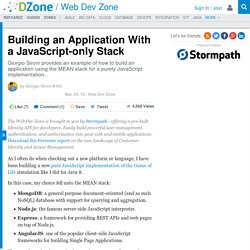
Easily build powerful user management, authentication, and authorization into your web and mobile applications. Download this Forrester report on the new landscape of Customer Identity and Access Management. As I often do when checking out a new platform or language, I have been building a new pure JavaScript implementation of the Game of Life simulation like I did for Java 8. Node.js Tutorial. Why Use Node.js? A Comprehensive Introduction and Examples. Introduction JavaScript’s rising popularity has brought with it a lot of changes, and the face of web development today is dramatically different.
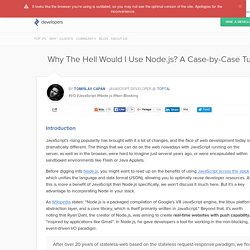
The things that we can do on the web nowadays with JavaScript running on the server, as well as in the browser, were hard to imagine just several years ago, or were encapsulated within sandboxed environments like Flash or Java Applets. Before digging into Node.js, you might want to read up on the benefits of using JavaScript across the stack which unifies the language and data format (JSON), allowing you to optimally reuse developer resources. As this is more a benefit of JavaScript than Node.js specifically, we won’t discuss it much here.
But it’s a key advantage to incorporating Node in your stack. As Wikipedia states: “Node.js is a packaged compilation of Google’s V8 JavaScript engine, the libuv platform abstraction layer, and a core library, which is itself primarily written in JavaScript.” How Does It Work? MartinChavez/Node.js-Tutorial. Single-Page Applications: Building a Web Stack That Works. Single-Page Applications: Building a Web Stack That Works Or, “How We Can Separate Our Concerns to Make Life Easier for Everybody” Whether you’re a professional developer, the CTO of a new startup, or just a hobbyist, the benefits of having a single-page application (SPA) are tremendous.
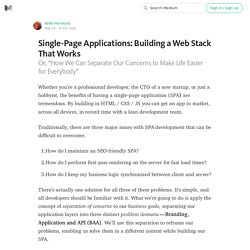
By building in HTML / CSS / JS you can get an app to market, across all devices, in record time with a lean development team. Traditionally, there are three major issues with SPA development that can be difficult to overcome. How do I maintain an SEO-friendly SPA? There’s actually one solution for all three of these problems. Problem #1 How do I maintain an SEO-friendly SPA? Solution: Separate your concerns! Creating a Simple RESTful Web App with Node.js, Express, and MongoDB. Creating a Single Page Todo App with Node and Angular. Today we will be creating a very simple Todo application using the MEAN (Mongo, Express, Angular, Node) stack.
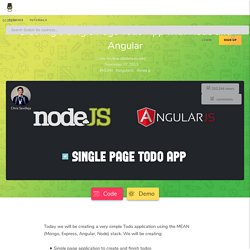
We will be creating: Single page application to create and finish todosStoring todos in a MongoDB using MongooseUsing the Express frameworkCreating a RESTful Node APIUsing Angular for the frontend and to access the API While the application is simple and beginner to intermediate level in its own right, the concepts here can apply to much more advanced apps. The biggest things we should focus on is using Node as an API and Angular as the frontend. Making them work together can be a bit confusing so this tutorial should help alleviate some confusion. What We'll Be Building Base Setup File Structure We are going to keep the file structure very simple and put most of the code for our Node application into the server.js file. . - public ----- core.js ----- index.html - package.json - server.js Installing Modules In Node, the package.json file holds the configuration for our app. Build a real-time polls application with Node.js, Express, AngularJS, and MongoDB.
Recently while lecturing on HTML5 to a large group of students, I wanted to poll them and display their voting results, updating in real-time.
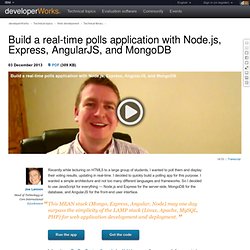
I decided to quickly build a polling app for this purpose. I wanted a simple architecture and not too many different languages and frameworks. So I decided to use JavaScript for everything — Node.js and Express for the server-side, MongoDB for the database, and AngularJS for the front-end user interface. “This MEAN stack (Mongo, Express, Angular, Node) may one day surpass the simplicity of the LAMP stack (Linux, Apache, MySQL, PHP) for web application development and deployment.”
I chose to use DevOps Services (formerly JazzHub) to manage the source code for my project. What you'll need to build your app. Mastering MEAN: Introducing the MEAN stack. Develop and deploy your nextapp on the IBM Bluemixcloud platform.
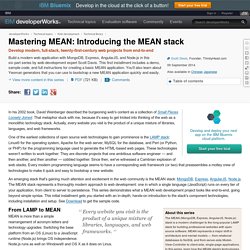
Start your free trial In his 2002 book, David Weinberger described the burgeoning web's content as a collection of Small Pieces Loosely Joined. That metaphor stuck with me, because it's easy to get tricked into thinking of the web as a monolithic technology stack. Actually, every website you visit is the product of a unique mixture of libraries, languages, and web frameworks. One of the earliest collections of open source web technologies to gain prominence is the LAMP stack: Linux® for the operating system, Apache for the web server, MySQL for the database, and Perl (or Python, or PHP) for the programming language used to generate the HTML-based web pages.